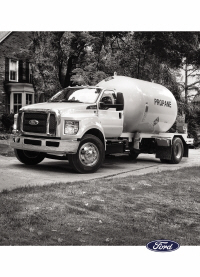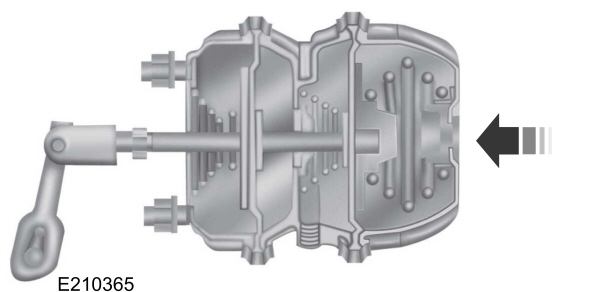This view of the Owner's Manual contains the very latest information, which may vary slightly from the printed Owner's Manual originally provided with your vehicle. It may also describe content that is not on or operates differently on your vehicle. Please consider the Owner's Manual originally provided with your vehicle as the primary source of information for your vehicle.

The information contained in this publication was correct at the time of release.In the interest of continuous development, we reserve the right to change specifications, design or equipment at any time without notice or obligation.No part of this publication may be reproduced, transmitted, stored in a retrieval system or translated into any language in any form by any means without our written permission.Errors and omissions excepted.
Copyright © 2024 Ford Motor Company
Parking Brake
 The parking brake warning lamp illuminates and remains illuminated until you release the parking brake.
The parking brake warning lamp illuminates and remains illuminated until you release the parking brake.

 The parking brake warning lamp illuminates and remains illuminated until you release the parking brake.
The parking brake warning lamp illuminates and remains illuminated until you release the parking brake.


Hydraulic Brakes (If Equipped)
 WARNING:
Always set the parking brake and leave your vehicle with the transmission in park (P).
WARNING:
Always set the parking brake and leave your vehicle with the transmission in park (P). WARNING:
This control is for parking only. Do not leave the vehicle unattended after setting the parking brake without placing the transmission in park (P). We recommend using wheel chocks for hilly or off-road circumstances.
WARNING:
This control is for parking only. Do not leave the vehicle unattended after setting the parking brake without placing the transmission in park (P). We recommend using wheel chocks for hilly or off-road circumstances. WARNING:
Unexpected and possibly sudden vehicle movement may occur if you do not take these precautions.
WARNING:
Unexpected and possibly sudden vehicle movement may occur if you do not take these precautions. WARNING:
If the parking brake is fully released, but the brake warning lamp remains illuminated, the brakes may not be working properly. Have your vehicle checked as soon as possible.
WARNING:
If the parking brake is fully released, but the brake warning lamp remains illuminated, the brakes may not be working properly. Have your vehicle checked as soon as possible. |
Apply the parking brake whenever the vehicle is parked. To set the parking brake, pull the handle up until it snaps into the locked position.
When the parking brake is out of adjustment, immediately seek service.
 The parking brake warning lamp illuminates and remains illuminated until you release the parking brake.
The parking brake warning lamp illuminates and remains illuminated until you release the parking brake.
Push the palm release lever (A) and push down on the parking brake handle (B) as far as possible to release the parking brake. Driving with the parking brake on causes the brakes to wear out quickly and reduces fuel economy.
We recommend you not use the parking brake to stop a moving vehicle. However, if the normal brakes fail, you can use the parking brake to stop your vehicle in an emergency. Since the parking brake only slows the rear wheels, the vehicle's stopping distance increases greatly and the handling of your vehicle is adversely affected.
Releasing Spring Manually
 WARNING:
Do not attempt to disassemble the parking brake air chamber under any circumstances as this may cause serious injury.
WARNING:
Do not attempt to disassemble the parking brake air chamber under any circumstances as this may cause serious injury. WARNING:
Block the wheels to help prevent the vehicle from moving.
WARNING:
Block the wheels to help prevent the vehicle from moving. WARNING:
Unexpected and possibly sudden vehicle movement may occur if you do not take these precautions.
WARNING:
Unexpected and possibly sudden vehicle movement may occur if you do not take these precautions. |
If you release hydraulic pressure from the spring brake chamber, the power spring applies the brake. If the hydraulic pressure can be re-established, you must release the spring brake to move your vehicle.
Air Brakes (If Equipped)
 WARNING:
This control is for parking only. Do not leave the vehicle unattended after setting the parking brake without placing the transmission in park (P). We recommend using wheel chocks for hilly or off-road circumstances.
WARNING:
This control is for parking only. Do not leave the vehicle unattended after setting the parking brake without placing the transmission in park (P). We recommend using wheel chocks for hilly or off-road circumstances. |
If the service brakes fail to operate while your vehicle is moving, you can make an emergency stop with the parking brake. Since the parking brake only applies stopping power to the rear wheels, your vehicle’s stopping distance greatly increases and the handling of your vehicle is adversely affected. Make repairs immediately to an inoperative air brake system circuit.

Pull the yellow, dash-mounted parking brake knob to apply the parking brake.
 The parking brake warning lamp illuminates and remains illuminated until you release the parking brake.
The parking brake warning lamp illuminates and remains illuminated until you release the parking brake.Releasing the Parking Brake
 WARNING:
When your vehicle is stationary, keep the brake pedal fully pressed when shifting gears. Failure to follow this instruction could result in personal injury, death or property damage.
WARNING:
When your vehicle is stationary, keep the brake pedal fully pressed when shifting gears. Failure to follow this instruction could result in personal injury, death or property damage. |
Note:
Read and understand the following steps and perform them whenever you prepare to drive the vehicle.
Note:
The parking brake does not disengage unless sufficient system air pressure is available.
- Press and hold the service brake pedal while the engine is running.
- Select the appropriate drive gear.
- Push and hold the yellow dash-mounted parking brake knob until the parking brake warning lamp turns off, then release.
Parking Brake Light Illumination Due to Low Air Pressure
If the air pressure becomes too low at any time during vehicle operation, the parking brake may apply and the parking brake warning lamp turns on.
If the parking brake applies due to low air pressure, immediate service is required to the parking brake system.
Releasing Spring Brake with Air Pressure
The air system in all vehicles with spring-actuated rear wheel parking brakes has a valve on the governor for connection to an outside air supply. The valve lets you recharge the system with air from an outside source, releasing the spring-actuated parking brakes. Your vehicle is now ready to tow in an emergency.
You can only use an outside air source if the protected system is in an operating condition. If you cannot restore air pressure in the protected air system, you must manually release the spring-actuated brakes.
Releasing Spring Manually
Do not use impact wrenches as they may damage the piston and prevent proper caging of the spring. Do not apply more than
50 lb.ft (68 Nm) to the release bolt nut.
- Remove the stud tool and nut from the carrying pocket on the brake chamber assembly.

- Remove the access plug from the end of the spring chamber.
- Insert the release stud through the opening in the chamber and into the spring pressure plate.

- Turn the release stud ¼ turn to engage the stud tangs with the slot in the pressure plate. Keep the stud engaged and install the nut on the release stud.
- Tighten the nut until the spring is fully caged and brakes released. Do not loosen or remove the release stud and nut unless you completely assemble and securely clamp the brake chamber.
- After restoring the air pressure, unscrew and remove the release stud and install in the carrying pocket. Install the access plug.
- Please note that Ford will not respond to individual feedback.
- Please provide detailed feedback regarding any inaccuracies in the content or any missing content in the Owner's Manual.
- Your feedback will be investigated, and any necessary changes will be updated in the online Owner's Manual.
Your input is valuable in helping us improve our Owner's Manual. Thank you for taking the time to provide your feedback.
